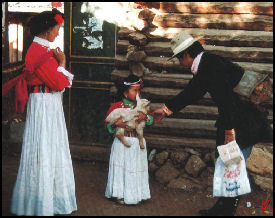
The Blades of the Rose are sworn to protect the sources of magic in the world. But the work is dangerous--and they can't always protect their own...***
READY FOR ACTION...
London Harcourt's father is bent on subjugating the world's magic to British rule. But since London is a mere female, he hasn't bothered to tell her so. He's said only that he's leading a voyage to the Greek isles. No matter, after a smothering marriage and three years of straitlaced widowhood, London jumps at the opportunity--unfortunately, right into the arms of Bennett Day.
RISKING IT ALL...
Bennett is a ladies' man, when he's not dodging lethal attacks to protect the powers of the ancients from men like London's father. Sometimes, he's a ladies' man even when he is dodging them. But the minute he sees London he knows she will require his full attention. The woman is lovely, brilliant, and the only known speaker of a dialect of ancient Greek that holds the key to calling down the wrath of the gods. Bennett will be risking his life again--but around London, what really worries him is the danger to his heart...
Publishers Weekly selected SCOUNDREL as a Pick of the Week!
"Archer follows 2010's WARRIOR with another delightful tale of an intelligent, competent woman sharing adventure and romance with a formidable partner... London's personal growth paces the adventure story beautifully, and readers will cheer for both the romance and the Blades." ~ Publishers Weekly
***
"How did you know I was from England?" she asked. "The vendor was speaking English to everyone."
"Your posture. English ladies have a particular way of holding themselves, as though a disapproving governess was glaring at them."
"Different than, say, a French or Greek lady?"
"There's bundles more self-imposed Anglican morality in an Englishwoman's stance. I am," he added, with a slow, suggestive smile, "an avid connoisseur of the language of the body."
"Of that, I have no doubt," she said, dry.
His chuckle was low and velvet and very, very carnal. If he was unleashed on polite British society, virgin debutantes and genteel matrons would turn into Bacchae, tearing at their clothes and ripping apart anyone foolish enough to stand between themselves and the object of their desire. She felt much the same uncharacteristic urge.
London busied herself with pretending to admire a gold silk scarf at a booth. As she did this, she sent a cautious glance towards the beautiful English stranger. With a small, internal start, she realized that his stance only appeared to be negligent and easy. He was, in fact, vigilant, ready as if poised for movement. And his eyes, though glittering with a secret amusement, were never at rest. He watched the marketplace, keen as a blade. He was looking for someone.
But who? She dare not ask such an impertinent question, and didn't know if she wanted the answer. There was something, the edge of a darkness, in him, or, at the least, a potential for danger. She wondered if he was armed. Travelers to Greece were advised to bring at least a revolver if they planned on leaving Athens. But this man's strong body would be weapon enough.
"Is it within the rules to ask what brings you to Greece?" London asked.
"Never said there were any rules." A small dimple appeared in the corner of his mouth. London wanted to touch it. Or, better yet, feel it with her lips.
"If there were," she said, "you don't play by them."
He gave an unapologetic shrug. "Following rules means there's no fun or pleasure in life."
She was certain he had both in abundance. "And decorum? Responsibility?"
"Decorum stifles. Women, especially."
London picked up the scarf and draped it around her shoulders, as a lady might at the ballet. "That sounds like a libertine's well-practiced speech to lure women into dalliance."
"There's always truth in seduction. That's why it works." He stepped closer and loosened the scarf from her shoulders, then he gently wrapped it around her waist like a sash. She felt it like an embrace. His deft, long fingers tied the fabric into a decorative knot. "Much better. More Greek," he murmured in approval.
London's pulse sped at his nearness, yet she did not step away. "But what of responsibility?"
He gazed at her levelly, and in his clear aquatic eyes, she saw a steadiness of purpose that she had not anticipated. "I take my responsibilities seriously."
"They must be the only things you take seriously," she answered.
No mistaking the way he looked at her, how his gaze flicked down to her mouth and held there for more than a moment. "Try me, little troublemaker."
She felt herself standing above the sea, the warm water beckoning her to plunge into its wet, welcoming depths, frolic in its waves. She wanted to jump. She was afraid of the height. "Sir, you are more dangerous than Barbary pirate," she said, after a breathless pause.
Again, he laughed, something he seemed to do readily. A bedroom laugh. Teasing. Intimate. And such a laugh made her body respond without thought. Her skin felt sensitive and a molten heat gathered in her core. Oh, it had been a long time since a man touched her, and not a single, half-hearted caress from Lawrence affected her as one laugh from this stranger did. She recalled how, moments earlier, his fingers had brushed her hand, and the strange, intense response even that minor contact had engendered.
"Know many Barbary pirates?" he asked, one eyebrow raised.
"I do, now."
It was then that she realized something. All this time, he had been speaking to her as his equal. Granted, he was a devil of a flirt, but he did not seem to consider her female sex a liability. He talked truthfully, openly, without the polite phrases or evasions so common to the speech of every other man she knew. And when she answered him, it was as if she'd unlatched a little door inside herself and could meet him on the level ground, confident in herself.
"I think you are the dangerous one," he said, "but you don't know it yet."
Again, their eyes caught and held. No, she was not imagining it. Something hot and knowing in their shared look. And that other thing, that tie that bound them in ways she did not understand.





.jpg)







































